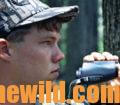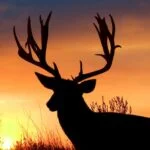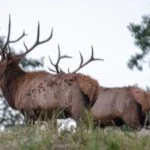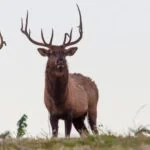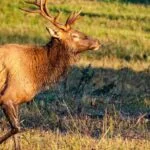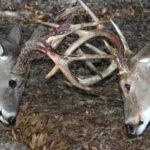Editor’s Note: One of the most-effective methods of taking game is stalking. Man was not the originator of stalking techniques, but merely the imitator. He observed cats as they stalked and killed their prey. He watched foxes move in close for their attacks. He saw other predators as they closed the distance and then came in for the kill. Because of his primitive weapons – his spear, knife and bow and arrow – early man had to learn to stalk in close if he wanted to harvest game and survive. He was a part of all that was around him. He moved with the ease of a warm summer’s breeze that never had been seen and barely felt. He was a predator who moved in for a clean kill and then left. He was a silent stalker of deer.
George Johnson, a farmer and hunting-camp operator in Louisiana, believes that his chances of taking a buck deer are greatest in a feeding area. “I spend a lot of time trying to find exactly where deer are feeding. I know that in my part of the country, they’re feeding primarily on acorns during hunting season. So, when I go into the woods, I look for a spot that has 15 to 20 acorn trees all in 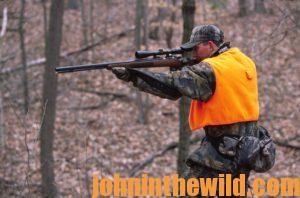 a clump. Next I check for a large amount of fresh droppings and tracks and an abundance of acorns on the ground. Once I find a good spot, I leave it and don’t return for at least two days. Then whatever human scent I may have brought into the feeding ground will have dissipated, and the deer should return to their normal feeding patterns.”
a clump. Next I check for a large amount of fresh droppings and tracks and an abundance of acorns on the ground. Once I find a good spot, I leave it and don’t return for at least two days. Then whatever human scent I may have brought into the feeding ground will have dissipated, and the deer should return to their normal feeding patterns.”
Many hunters will make noise on the way to the places they’re hunting. But this action has a domino effect. As the hunters spook animals out in front of them, these animals will move out and spook the deer in the area the hunters are planning to stalk. So Johnson’s extremely quiet going to his hunting grounds.
“One place I stalk requires crossing a creek,” Johnson reports.” “I have friends who hunt this same region. They utilize an aluminum boat to cross the creek – banging around and spooking everything. When they arrive at the hunting spot, they almost always are unsuccessful in taking deer. However, I have been extremely successful in getting deer on this section of land, because I wade the creek and make little or no noise while trying to reach my hunting spot.”
Johnson hunts from daylight until 10:00 am or from 2:00 pm until dark. He stalks all the way to where he plans to hunt. Generally he takes his deer within the first 75-100 yards he’s hunting. He mentally decides he won’t move more than 400 yards in the time he’s allotted myself to be in that area. He chooses a route to move along the edge of the feeding site that will provide him cover. Then th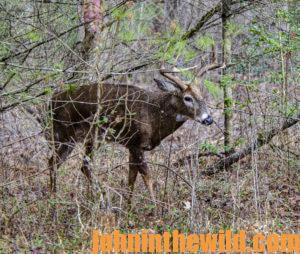 at deer will have less chance of seeing him while they feed. When he stops, he always leans up against a tree to keep from being silhouetted.
at deer will have less chance of seeing him while they feed. When he stops, he always leans up against a tree to keep from being silhouetted.
“I stalk hunt deer much like I stalk hunt squirrels,” Johnson explains.” “I slip slowly and quietly from tree to tree without being detected. I never hunt a road. I never move more than three steps at a time. After I’ve taken three steps, I wait at least 5 minutes before moving again. If I see does, I may stand still for 15 or 20 minutes in the same spot. Usually bucks will be feeding a short distance from the does. By standing perfectly still and watching the edges of the feeding ground, I may see the movement of a horn or an ear twitch that will give away the buck’s position.”
Johnson’s discovered that the most-effective technique is to hunt across the wind. Deer feed with the wind coming from behind them. With their heads down, they can smell anything that approaches from the rear. When they look up, they can see anything in front of them that may be moving toward them. When Johnson stalks cross-wind, he feels as though he’s coming toward the deer on his blind side, where he neither can see nor smell Johnson.
“However, we know the deer’s senses of sight and smell aren’t the only senses he uses to determine danger,” Johnson emphasizes. “Deer are alerted by barking squirrels and frightened woods birds. A successful stalk is when a man goes into the woods and moves through the woods without alarming any animals. Deer know the distress calls of other animals. I believe they react to these other animals’ alarm calls to stay alive.”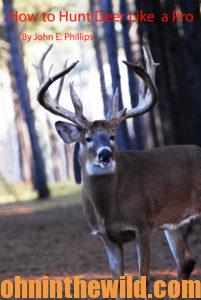
Most of the time in the woods Johnson hunts deer to insure he never will has a shot longer than 100 yards. His favorite two shots he waits on are a rear shot or a shot on the front shoulder. He’s learned that if he places the bullet close to the anus of the deer, the buck will drop instantly. If he hits the point of the deer’s shoulder, he may break both shoulders and cause severe heart and lung damage that will drop the buck where he stands. If Johnson takes a deer in an area, he doesn’t hunt that same region again for a week. He wants everything to return to normal again before he goes back in to this region to try and take another deer.
To learn more about hunting deer, check out John E. Phillips’ book, “How to Hunt Deer Like a Pro,” available in Kindle, Print and Audible versions, at (http://amzn.to/YpoQHA). You may have to copy and paste this click into your browser. (When you click on this book, notice on the left where Amazon allows you to read 10% of the book for free).
Tomorrow: Stalk Hunting Trails for Buck Deer


